Cannabinoids as Modulators of Neuronal Function - PowerPoint PPT Presentation
1 / 13
Title:
Cannabinoids as Modulators of Neuronal Function
Description:
Tetrahydrocannabinol-THC-isolated from Cannabis sativa in 1965 by Mechoulam ... CB1 cloned in 1990; G-protein coupled; various effects including inhibition of ... – PowerPoint PPT presentation
Number of Views:194
Avg rating:3.0/5.0
Title: Cannabinoids as Modulators of Neuronal Function
1
Cannabinoids as Modulators of Neuronal Function
- Exogenous cannabinoids
- Tetrahydrocannabinol-THC-isolated from Cannabis
sativa in 1965 by Mechoulam - Endogenous cannabinoids
- Anandamide
- 2-arachidonyl-glycerol (2-AG)
2
Endogenous Cannabinoid Life Cycle
- Biosynthesis-from membrane phospholipids
- On-demand not stored like classical transmitters
3
Endogenous Cannabinoid Life Cycle
- Transport and degradation
- Anandamide and 2-AG transport (facillitated
diffusion) AM404 inhibitor - Hydrolysis by FAAH (fatty acid amide hydrolase)
- FAAH KO display enhanced sensitivity to anandamide
4
Cannabinoid Receptors
- Originally demonstrated with specific binding of
CP-55940 a synthetic cannabinoid agonist - CB1 cloned in 1990 G-protein coupled various
effects including inhibition of adenylate
cyclase, modulation of voltage-dependent calcium,
potassium channels - CB1 antagonist-SR141716A (Rimonabant)
- CB2-40 sequence similarity found in many immune
system cells - CB1 knockouts eliminate most (but not all) of the
CNS effects of THC
5
Cannabinoid Receptors
- Mapped originally with CP-55940 autoradiography
then with mRNA - Highest density of any G-protein coupled receptor
- Basal ganglia and cerebellum among the highest
labelling-also high cortical/hippocampal areas - GTPgS autoradiography reveals high functional
activation - Presynaptic location
6
Cannabinoid Effects-Behavior
- Billy Martin Quartet Distinct set of effects
produced by cannabimimetic drugs in animals - -rigid immobility (catalepsy)
- -decreased motor activity
- -analgesia
- -hypothermia
- Used to screen novel compounds for activity
7
Cannabinoid Effects-Cellular
- Endocannabinoids reduce GABAergic signaling
- Depolarization-induced suppression of inhibition
(DSI) - Synthesis and retrograde transport of an
endocannabinoid - CB1Rs linked to block of presynaptic N-type
calcium channels
8
Cannabinoid Effects-Cellular
- In some brain areas, CB1 receptors also reduce
glutamate release - DSE-depolarization induced suppression of
excitation - In CA1, DSE induced by the agonist WIN is not
blocked by rimonabant and persists in CB1 KO
mice-how?
9
Cannabinoid Effects-Cellular
- WIN also activates a vanilloid (pain TRPV1
channels) receptor - This effect is blocked by a TRPV1 antagonist,
capsazepine - EPSCs blocked by TRPV1 agonist, capsaicin
- Anandamide but not 2-AG also activates TRPV1
channels
10
Endocannabinoid Signaling
- On-demand synthesis- during periods of intense
stimulation - Calcium-dependent- may require simultaneous Ca
channel and metabotropic receptor activation
(mGluR, AchR) - CB1s located primarily on CCK containing GABA
interneurons
Figures taken from Freund et al., 2003 Physiol
Rev
11
Endocannabinoid Signaling
- What is physiological role of DSI?
- In PFC-excitatory and inhibitory neurons form
local circuits that regulate output of cortex - Neurons undergo persistent activity-sustained
periods of firing that are thought to underlie
working memory - DSI may enhance accuracy of working memory by
transiently strengthening persistent activity
only in those neurons involved in task (reduce
noise in the system)
Persistent activity in PFC neuron
12
Endocannabinoid Signaling
- Without DSI-persistent activity shows greater
drift from remembered cue location over time - With DSI, drift is reduced and accuracy is
maintained over time (reduced noise) - DSI stabilizes the pattern of activity involved
in remembering the location of the cue - But exogenous THC is associated with impaired not
improved memory-why?
13
Endocannabinoid Signaling
- Exogenous CB1 agonist like THC when applied
globally induces DSI non-selectively - Reduces accuracy due to increased firing of all
neurons - Consistent with human studies showing reduced
working memory after THC exposure
Endocannabinoids are thus regulators of
activity-dependent patterns of firing and
important modulators of neuronal plasticity































